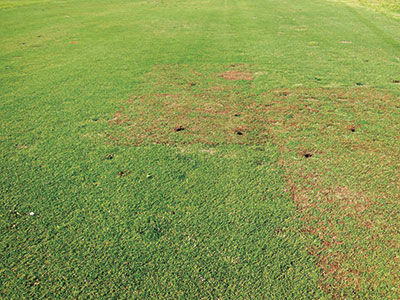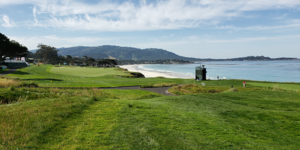Winter bermudagrass overseeding: Does it hurt or help?

At the University of Kentucky site, bermudagrass density declined in spring and was strongly associated with overseeding rate.
Bermudagrass (Cynodon dactylon) is the choice for golf course fairways and tees in the South and in the Transition Zone because it tolerates close mowing (less than 3/4 inch) and forms a dense, durable and persistent turf. One of the major drawbacks to bermudagrass is the straw-brown color during dormancy. To provide green color during winter and sometimes improve playability during slow-growth periods, superintendents often overseed with perennial ryegrass (Lolium perenne).
Several questions remain regarding winter overseeding. Poor spring density of bermudagrass is not uncommon after removing the overseeded species, but exactly why remains a mystery.
To examine this question, a study was initiated in 2014 at four locations — Blacksburg, Va.; Fayetteville, Ark.; Lexington, Ky.; and West Lafayette, Ind. Mature bermudagrass was overseeded with a perennial ryegrass blend at three rates (0, 650 and 1,300 pounds per acre) and surface soil temperature, carbohydrate content of rhizome/stolon tissue and visual observations of quality/green coverage were measured.
Soil temperature was quite variable, with only slight increases (1 to 1.5 degrees F) in the overseeded plots compared with non-overseeded turf at some sites on some dates. Physiological measurements during dormancy revealed that total carbohydrates and starches (long-chained sugars) declined with time regardless of overseeding rate at the most northern site, West Lafayette, Ind. Spring bermudagrass density declined at some sites, like Lexington, Ky., which was strongly associated with overseeding rate.
These studies reaffirm the potential negative effects of winter overseeding on bermudagrass spring density and physiological health. Continued research to examine the mechanisms responsible for decline and management practices that maximize bermudagrass winter health and survival would be helpful.
Cale Bigelow, Ph.D., and Kevin Jackson are at Purdue University, Gregg Munshaw, Ph.D., is at the University of Kentucky, Mike Richardson, Ph.D., is at the University of Arkansas, and Xunzhong Zhang Ph.D., and Mike Goatley, Ph.D., are at Virginia Tech University. You may reach Cale Bigelow at cbigelow@purdue.edu for more information.
Photo by: Gregg Munshaw.









